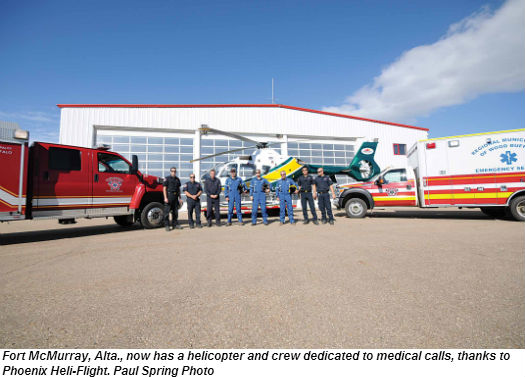Estimated reading time 6 minutes, 40 seconds.
Ever since Canada discovered how to extract black gold from its oil sands, people have been flocking to Fort McMurray, Alta., to find their fortunes. With 50,000 people currently living in remote work camps outside the city, plus an urban population of 77,000, you’d probably be surprised to discover that, until this summer, Fort Mac didn’t have a dedicated helicopter emergency medical service (HEMS).
But all that has changed, now that there’s a new Eurocopter EC135 in town.
The twin-engine helicopter resides in the Phoenix Heli-Flight hangar, where company president and CEO Paul Spring is no stranger to medevac missions. In cooperation with the local fire department (which also handles paramedic functions) Phoenix has been responding to “code red” calls on an ad hoc basis since the company was founded in 1992.
“Sometimes we’d do three per day,” said Spring, whose main business centers around ever-increasing oil sands work, firefighting, and forest management. “It was always there in the background. With the increase in industry here, we started having to turn down medical calls, either because our aircraft were busy, or because it was too close to dark and we were allowed to fly day VFR [visual flight rules] only.”
Then, in April 2012, a horrific collision on Highway 63 between Edmonton and Fort Mac left seven people dead.
“All of a sudden, it was in focus: how come Fort McMurray doesn’t have better service? That opened up the discussion a bit further,” recalled Spring. “I was explaining to politicians that what we do isn’t funded — it’s done on a casual charter basis, day only, and only if we’re available.”
For years, Spring had been working with area doctors to set up a dedicated local HEMS service with Alberta Health. But last year the doctors gave up, telling Spring to go ahead if he wanted to pursue the idea on a commercial basis.
“We thought about it real hard,” said Spring. “I talked to a lot of industry players, and said that industry would have to get involved with funding a dedicated helicopter. They said they would, so on Dec. 31 last year, we ordered a brand new EC135 based on nothing more than industry saying that if we got it, they’d fund it.”
The EC135 was chosen for a number of reasons — not all landings are completed on highways or at industrial sites, and skids are needed for touching down on the area’s spongy muskeg. Plus, added Spring, “having no tail rotor is an advantage when landing in confined areas, as well as less noise in the city.”
With the order placed, Spring and his team got to work establishing a separate and transparent company to run the service, named the Local HERO Foundation — with HERO standing for “helicopter emergency response organization.” Although medical calls will always take first priority, the helicopter will also be used by the RCMP, for pipeline emergencies, and by other organizations, as needed.
With the new helicopter’s arrival at least nine months away, Spring and his team focused on establishing the business end of things. But plans abruptly changed when he heard that another EC135 — owned by VIH Helicopters and the first of its kind in Canada — was coming off a contract in Alaska.
“We changed gears,” said Spring. “We decided patient care should come ahead of business care. We saw this opportunity to get a helicopter here and flying. So rather than introducing a service in January, we thought we’d do it in the summer.”
Phoenix leased VIH’s EC135 and it came online on July 26. From then until the time of writing in early September, it had performed a dozen “code red” medevacs. On one such trip, the crew transported a stroke victim to the hospital in 45 minutes, versus a three-hour journey by road.
For the time being, the helicopter and its crews are dedicated exclusively to medical calls. Until the promised funding is received from the major oil companies, Spring has to foot the bill for all fixed costs including lease payments, crew wages, and insurance. In addition, Phoenix is currently only reimbursed for “code red” medevacs approved by Alberta Health. Any other medical calls will likely come out of the Local HERO Foundation budget.
All the Bells and Whistles
The leased EC135 has been equipped for night vision goggle (NVG) operations, and Spring estimated that by mid-October, all necessary crew training should be completed. In addition, the new EC135 — a T2e model which is due to arrive this fall for finishing at Eurocopter Canada Ltd. in Fort Erie, Ont. — will feature roughed-in winch capability as well as FLIR (forward looking infrared) mounts.
“We’re following the crawl, walk, run philosophy — we’ll get used to operating the aircraft, NVG ops, the winch, and then FLIR,” said Spring. The FLIR capability will allow responders to search for lost people, as well as facilitating emergency detection of pipeline leaks.
The community is firmly behind the Local HERO Foundation. With the footprint of the oil sands expanding, and the workforce aging in general, medical emergencies are becoming more common.
“Everybody we talk to says, ‘Yes, you’re doing the right thing,’ ” concluded Spring. “Now we just need to round up the funding.”

